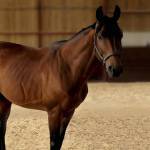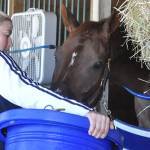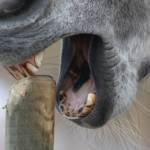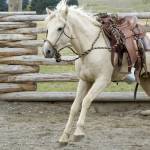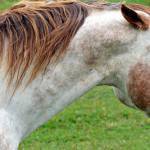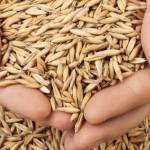Scoring Endometrial Biopsies to Predict Mare Fertility

Disease of the endometrium—the inner lining of the uterus—commonly results in decreased fertility. Because of this, veterinarians frequently perform uterine (endometrial) biopsies as part of a breeding soundness exam in mares that fail to either become pregnant or maintain a pregnancy. These biopsies are then evaluated microscopically and assigned a grade using the Kenney-Doig endometrial biopsy scoring system based on the degree of inflammation and fibrosis (scarring). This grade estimates the mare’s ability to conceive and maintain a pregnancy until term.
In brief, the different grades of the Kenney-Doig scoring system are:
- Grade I: normal endometrium or mild, focal inflammation or fibrosis. These mares have more than an 80% chance of conceiving and maintaining until term.
- Grade IIA: mild to moderate inflammation and/or multifocal fibrosis, and these mares have a 50% to 80% chance of conceiving and maintaining until term.
- Grade IIB: moderate inflammation and/or multifocal to diffuse fibrosis. These mares have anywhere from a 10% to 50% of conceiving and maintaining until term.
- Grade III: severe inflammation and/or diffuse fibrosis, and mares have less than a 10% chance of conceiving and maintaining until term.
The Kenney-Doig system, devised in 1986, is the international standard for grading endometrial biopsies, yet recent studies show that it has poor repeatability. Studies also suggest that pathologists shy away from the extreme categories (I or III in this case). In the case of the Kenney-Doig system, each category has a wide range of prognoses regarding the mare’s ability to produce a live foal. Even a small disagreement in grade can result in a large variation in the probability of a mare carrying a foal to term.
Hoping to improve the evaluation of uterine biopsies, Spanish researchers devised an alternate scoring system using a numeric grading scale that assigned a grade to inflammation (0-4), fibrosis (0-6), glandular density (0-4), and lymphatic lacunae (0-1), and then summed those to report a total score.*
Two hundred and one endometrial biopsies were evaluated by two pathologists using the traditional Kenney-Doig system and the novel numeric grading system. Only a slight to moderate level of agreement was noted between pathologists. Most disagreements occurred between adjacent Kenney-Doig grades.
“This study’s observations support the idea that the Kenney-Doig scale has significant limitations in providing objective assessment of endometrial histopathology,” wrote the research team.
Using the Kenney-Doig scale in combination with the numeric grading scale proposed by the researchers, however, resulted in an increased degree of agreement between the two pathologists.
“Being able to accurately assess the endometrium to predict future fertility is important as repeated unsuccessful breeding attempts are costly, both emotionally and financially, to owners. Mares have only a limited number of breeding attempts per season, and if she has a uterine condition that makes her unlikely to carry a foal to term then alternate breeding techniques may need to be considered, such as embryo transfer or ICSI,” said Kathleen Crandell, Ph.D., a nutritionist at Kentucky Equine Research.
Various treatments exist for managing endometritis and vary based on cause (i.e., post-breeding versus chronic infectious endometritis with the presence of biofilm). These treatments may include uterine lavage, ecbolic agents, ozone, and platelet-rich plasma.
Additionally, Dr. Tracey Chenier and colleagues at the University of Guelph are currently exploring the role of omega-3 fatty acids in endometritis, possibly as a way to reduce inflammation.
The marine-derived long-chain omega-3 fatty acids DHA and EPA found in E-O3 are used as precursors of local hormones and have anti-inflammatory and immune-strengthening effects. The reproductive benefits from supplementation include improved fertility for both mare and stallion.
*Martínez-Bartolomé, I., J. Masot, and C. Serres. Development of an equine endometrial histology scoring system to complement the Kenney-Doig scale. Reproduction in Domestic Animals 59 Suppl 3:e14614.

